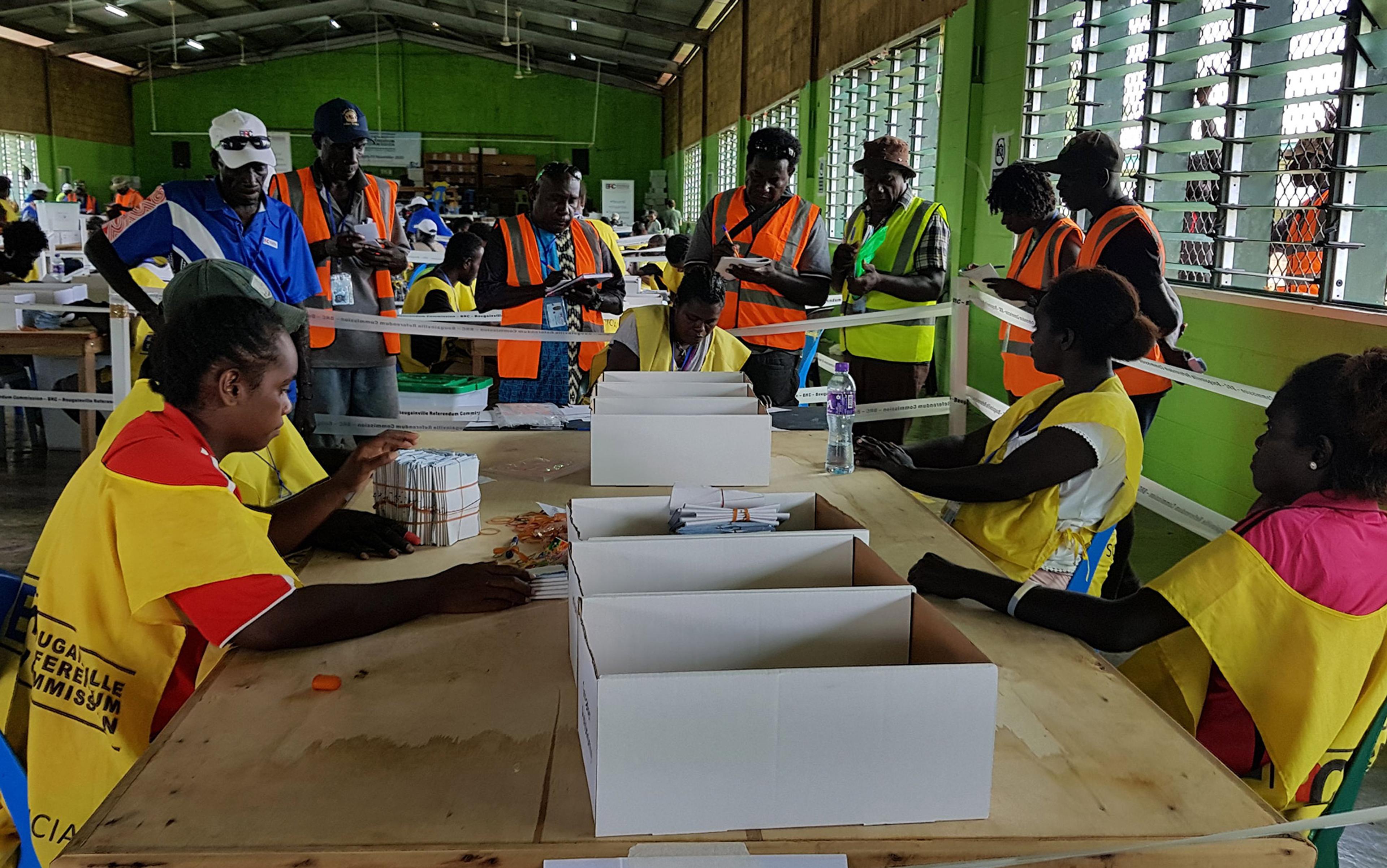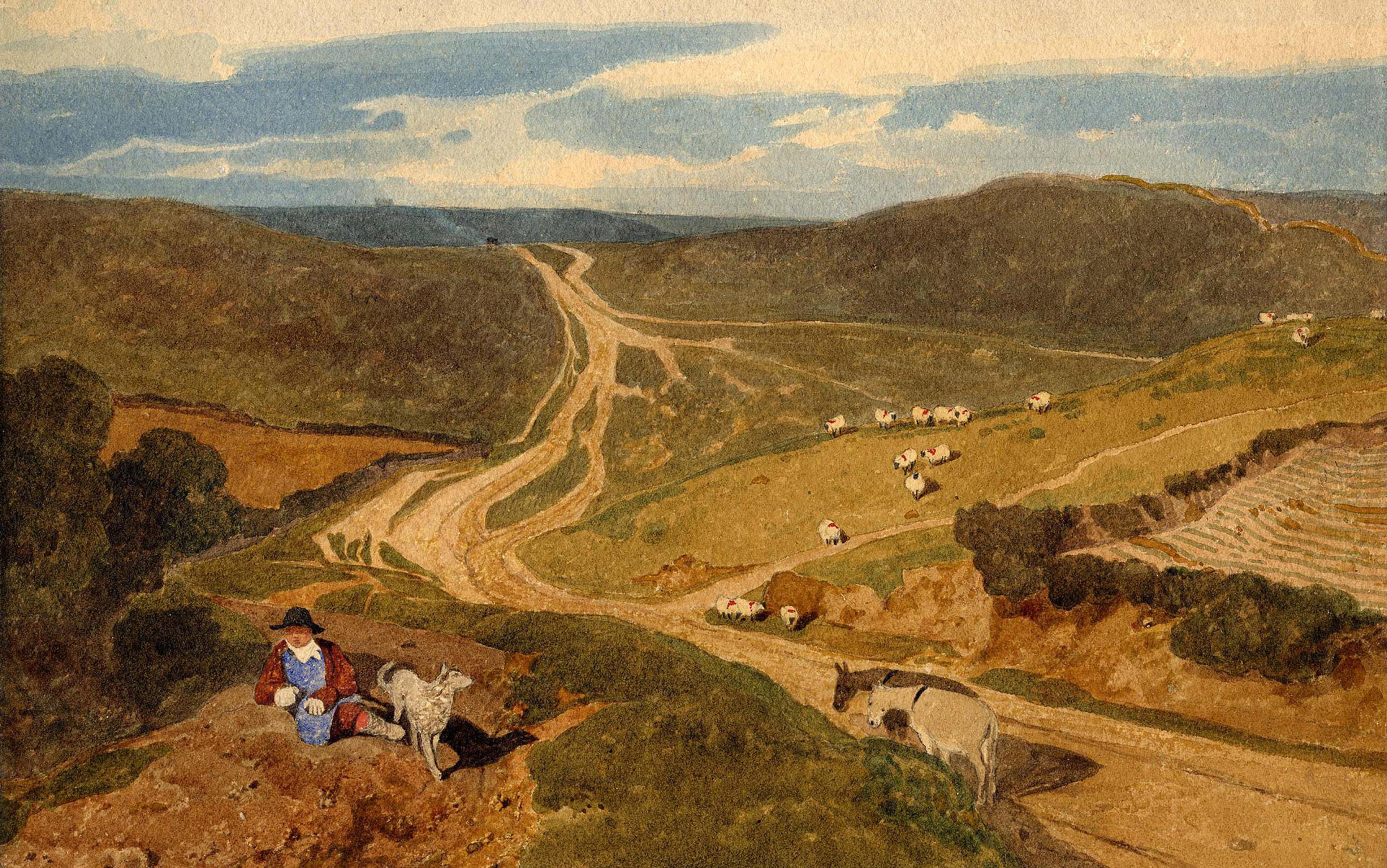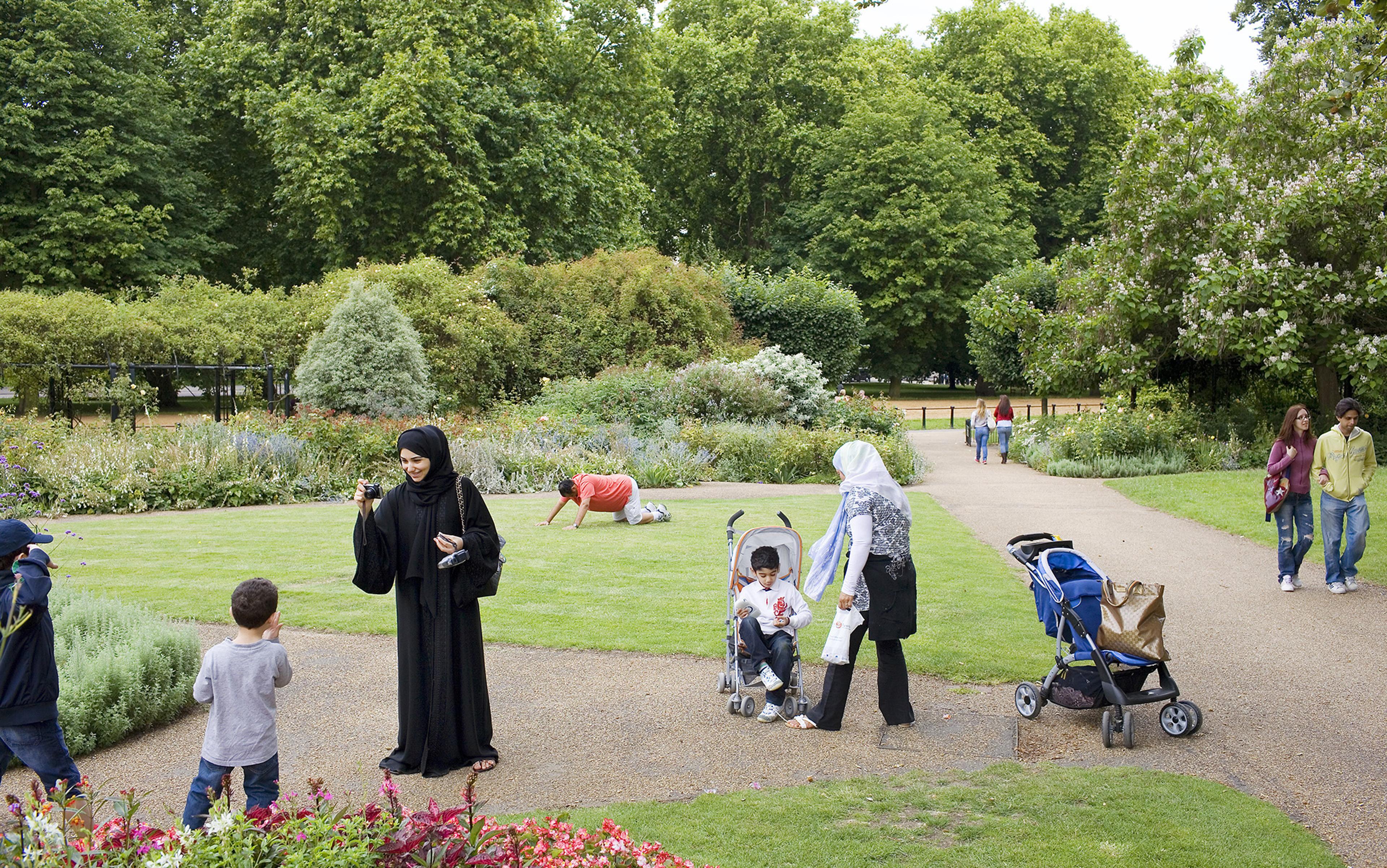We live in Canberra and Washington, DC, two stately capital cities that embody all the trappings and the ethos of the bureaucratic state. With their monuments, statues and symmetrical lines, the architects of both cities dreamt them as manifestations of the rational administrations that would work there. Imposing government buildings are the dominant architectural feature of both places, rising like redwood plantation trees in a planned forest. Irrespective of the decade or the party in charge, policies and plans that emerge from these buildings have the hallmarks of a planned forest, too: ordered, consistent and ostensibly guided by clear rules.
In terms of their scale, size and administrative grandeur, Canberra and Washington, DC are as different as can be from another city where we have both spent time: little Buka Town, the tumbledown, sun-scorched capital of Bougainville, presently an autonomous region of Papua New Guinea (and possibly soon the world’s newest country, after a 2019 referendum on independence, in which 97.7 per cent of the population voted in favour). In Buka, there is no capacious national repository to store administrative documents: the Bougainville government’s archives are a rusty-red shipping container into which papers get chucked periodically.
Ironically, though, it was in Buka that we found ourselves constantly bumping into the ghost of Max Weber, considered the father of bureaucracy (although he himself might bristle at that designation). Weber was a German sociologist writing at the beginning of the 20th century, a time when today’s state bureaucracy was emerging. He was an academic, not an administrator, omnivorous in his interests and prodigious in his outputs, including his classic, The Theory of Social and Economic Organisation (1920). His writing is now so associated with bureaucracy that the system of administration that he described is often designated as ‘Weberian’, as if he had championed the idea himself. Notwithstanding how voluminous the corpus of literature on public administration has become, Weber remains its lodestar and central reference point.
Weber’s ideal type of bureaucracy was a hierarchy in which adroit staff served public rather than private interests. They would be appointed based on merit. Personal preferences or peccadilloes would not impinge upon government decision-making. This Weberian ideal of public administration – high levels of specialisation, hierarchy, meritocracy and adherence to written rules – has become the copy-and-paste guide for creating bureaucratic systems all over the world. Thus, Bougainville’s system is a mini version of Papua New Guinea’s system, which is based on Australia’s system, which in turn is quite like that of the United Kingdom.
Few of these Weberian characteristics were on display in Buka. The apparatuses of sophisticated bureaucracy were missing. There was little in the way of specialisation, hierarchy or written rules. But when we stopped focusing on what wasn’t there and started to observe what was actually working to produce the administration of the state in Bougainville, a very different set of insights emerged. It was relationships, not bureaucratic wish-casting, that explained how decisions emerged as they did.
Our attention, like that of many public management theorists, had been too much ‘above ground’, focusing on the formal structures, hierarchies, institutions and rules so beloved by followers of Weber, and so heavily promoted by international bodies such as the Organisation for Economic Co-operation and Development, the World Bank and governments across the globe. But it was what was going on ‘below ground’ that was really intriguing, and that revealed some important new ways of thinking about public administration, not only in Buka, but in Canberra, Washington, DC and every other place where there is an administration. In short: bureaucracies should be seen as living gardens, not concrete buildings.
We lived and worked in Buka over the past decade – one of us (Gordon Peake) as a consultant and later as an adviser to its government, the other (Miranda Forsyth) as a researcher leading a project on sorcery accusation-related violence. Buka is a small place, no more than 2,000 people in a region of 30,000. In our everyday encounters there – at church, at the market, in the aisles of the stores that sell dazzling arrays of canned luncheon meats – we observed the close relationships among individuals. People are intensely known to each other through marriages, religion, family connections or positions taken during the region’s 10-year conflict. There is little or no anonymity in this place. It was mostly a peaceful town, with little need for formal police investigations when problems did occur. Everyone already knew who had done it.
The government had 14 departments, each with grandiloquent Weberian titles such ‘Personnel Management and Administrative Services’, ‘Lands, Physical Planning, Environment and Conservation’, ‘Police, Corrective Services and Justice’ – though there were often fewer people inside the offices than words in the department’s name. There is no semblance of security or separateness in these offices. Members of the public can and do wander in to see kith and kin.
Like their counterparts elsewhere, this government was replete with many noble and thoughtful plans, such as those forming its ‘Strategic Development Plan, 2018-22’. Such plans embody a bureaucratic model of government drawn straight from a public management psalter. There are close to 250 complex and ambitious tasks laid out in this particular plan – everything from developing legislation on pornography, to the establishment of ‘geotech data bases’. Implementing such an ambitious agenda would challenge any administration but especially one as small as the Bougainville government, which had just 500 bureaucrats on the books. Little to none of it has been accomplished. The plan sank largely without trace in the years since, bobbing up occasionally as an overture to the launch of more ambitious plans, most recently a ‘Bougainville Vision and Strategic Development Plan 2052 Framework’.
What was missing was the important role that individuals were playing in making things happen
Yet, at the same time, this was an administration that seemed capable of doing extraordinary things. It collected weapons left over from a bitter conflict with Papua New Guinea, putting them into an old bank vault and soldering it shut. It organised with the Catholic church the arrival of a spiritually important statue. It ran elections effectively and, most triumphantly of all, helped in delivering that successful referendum on the region’s political status. Few of these tasks were spelled out in any of the plans that putatively drove their work.
As we tried to make sense of this, we couldn’t find much in the academic literature on public service that helped explain what we were seeing. Most accounts were of deficit, intimating that more bureaucratic fiddling and structure-changing was required. When it came to the notion of relationality (the role of personal relationships in a network or bureaucracy), there was a well-developed wordlist to account for its negative effects: corruption, cronyism, nepotism, clientelism, the deep state, and neopatrimonialism to name a few. But there is no equivalent language to represent the positive spectrum of relationality in governance.
Seeing the public servants of Bougainville and the state apparatus through the lens of the bureaucratic state alone was farcical. There was a bureaucracy, to be sure, but it was only a small part of the story. What was missing was the important role that individuals were playing in making things happen. In seeing only ‘the office’ rather than the individuals seated within it, we were missing what we call the ‘relational state’. This state is located out of direct view, where the bureaucrats develop and leverage their relational ties, histories, connections and affiliations to get stuff done.
This relational state is something like the underground network of fungi that connects whole forests together. When the Canadian forester and scholar Suzanne Simard first proposed the existence of such a network, and the importance of ‘mother trees’ that actively share water, carbon, nutrients and other forms of support within eco-systems, she was ridiculed. It overturned established ideas that plants are engaged in competition for resources and battle for survival, requiring a fundamental rethink of forest management and much more. Simard had to ‘prove’ the existence of these underground networks in a series of experiments, as the tiny mycorrhizal networks and their operations are so hard to directly perceive. In similar ways, we began to wonder whether the relationality that nourishes the relational state is equally invisible when one looks only at formal buildings and official titles, and not at the practices and behaviours performed every day.
In Buka, human emotions, relationships and preferences were harnessed for official duties in the service of the state, and sometimes vice-versa. This was why the government of Bougainville worked (or didn’t work) the way it did. The relational state was hiding there in plain sight, as long as one knew how to look. So the question becomes: how can the relational state be reconciled with Weber?
In many ways, the Weberian ideal remains a Camelot that reformers strive for but never quite reach. This would probably be a huge relief to Weber himself, who presented his ideas as an ‘ideal type’ rather than the blueprint into which it has been reified subsequently. To be sure, there has been criticism by the truckload of the Weberian ideal, and the ‘delusions of confidence’ caused by its emphasis on rationality and order. Yet it remains paramount.
These reformist initiatives to improve bureaucratic performance have modernist names – New Public Management, the Neo-Weberian State, New Public Governance – but all tend to focus squarely on structures and systems, thereby overlooking or minimising the role of individuals. The bureaucrat working within these models, if mentioned at all, is mostly faceless, never named and never assumed to have any individual agency.
These reforms often come to naught. Two leading scholars on public management reform, Christopher Pollitt and Geert Bouckaert, argue that, despite all the announcements about the machinery of government being on the verge of ‘transformation’, the indictors of governance (levels of trust, big spenders, law-oriented, etc) remain similar to what they were many years ago. They argue that the ‘detail of public sector reforms often turns out to be more like geological sedimentation, where new layers overlie but do not replace or completely wash away the previous layer’. An established pattern is set where the same rationalistic, performance-oriented reform is introduced over and over again, despite the fact that it never seems to work even remotely as originally hoped.
The most adjacent literature to explore the importance of individuals is that concerned with ‘street-level bureaucracy’, a term coined by the sociologist Michael Lipsky in the late 1960s. Lipsky’s focus was on the lowest rung of public servants in the United States, who worked most closely with the public: police officers, teachers, social workers. His big insight was that the autonomy and discretion of their positions enabled them, in effect, to be policymakers and policy-setters in their relatively small domains.
Like the trees and the fungi in the forest, the street-level bureaucrats of Bougainville are inextricably entangled
Lipsky’s initial findings were cautious. He felt, for example, that bureaucratic discretion resulted from coping with administrative dilemmas, rather than from the bureaucrats’ own self-directed values and preferences. He also confined his analysis to those at the street level, forced by their position to translate universalising policies into actual decisions in the context of the infinitely variable situations life threw at them. Lipsky’s work initially received little interest, but it has been on an upwards trajectory ever since. New generations of scholars have come to appreciate the way in which his insight cuts through much of the smoke and mirrors generated in the quest for the Weberian Camelot.
In Buka, Lipsky helped us to formulate our own understanding of what was going on. But we had to expand the notion of street-level bureaucrats significantly, because there was almost no heeded hierarchy or accountability structures within Bougainville’s administration. This meant it was not just those at the lowest level working as street-level bureaucrats. It was everyone.
We also see Lipsky’s street-level bureaucrats a lot more relationally and organically than he conceptualised them. Rather than using discretion as a coping mechanism against the difficulties of implementing state policy, we see these bureaucrats as active agents of both state and society. Just as the trees and the fungi in the forest are mutually constitutive and interdependent, the street-level bureaucrats of Bougainville are inextricably entangled in their relational networks. The relational forces of individuals, and the behaviours they drive over time, actually constitute the state. Seen in this way, the state is a dynamic and evolving system, a stark contrast to the rigid structure imagined by the bureaucratic state.
We could clearly see the relational state at work in Bougainville, but do these relationalities and relationships explain how things get done only in torpid tropical islands, or does it also apply in the cities like Canberra and Washington, DC? Sure, they look very different, but in terms of how governance works in these places, we’re not so sure. Possibly it is just easier to detect the centrality of relationships in a place like Buka where there is a thinner topsoil between the personal and the public. The soil is much thicker and harder to excavate in places where bureaucracies are more established above ground.
Go behind the doors of a government office in a major capital, tune in to a hallway conversation, or have drinks with the people who work there, and a more subterranean picture of how government works emerges than could be gleaned from perusal of the corporate plan. These conversations will be less about grand policy and as much about how personal dynamics in the here-and-now influence decision-making. This is not just an Australian or a US thing. We’ve heard dime-a-dozen variants of these types of conversations in the corridors of the United Nations.
There are thousands of relational dynamics that course through every office, which account as much as laws or policies for how decisions get taken, and why events unfold as they do. If the capital structures are redwoods, these relationships are the networks of roots, soil bacteria and fungi that link entire forests together, forming the relational ties that help shape, enable and explain the decisions that are made above ground.
The centrality of relationality was on visceral display last year in the three-way submarine fracas between Australia, the US and France. In late 2021, Australia and the US announced a new military alliance called AUKUS. As part of the new arrangements, Australia unilaterally cancelled a multi-billion-dollar submarine deal it had with a French company, instead opting to use UK and US technology to build a new fleet. France denied being told about the cancellation prior to Australia’s announcement, and its government reacted in the same way that we both would have if someone we trusted lied to us – with hurt, anger and a desire to humiliate. This torrent of reproach all led to some very undiplomatic language that stripped bare the majesty and pretences of diplomacy.
Asked by a reporter if he thought that Scott Morrison, Australia’s then prime minister, had lied to him, France’s president Emmanuel Macron fired back: ‘I don’t “think”. I know.’ This response revealed not just disappointment at an extremely expensive contract being cancelled. It was about the nature of the relationship between the two countries, and a feeling of intense betrayal as one was strung along and then dumped when a better deal became apparent. The Australian response kept firmly within the playbook of the bureaucratic state, with public justifications saturated with claims of bureaucratic rationality considering the ‘changed strategic environment’. Since then, Macron has won re-election and Morrison, whom he accused of being a bold-faced liar, has not. It’s been striking that one of the first actions of Morrison’s successor Anthony Albanese was to try to reactivate personal relationships between the two countries.
There’s something indecent about discussing how people getting along accounts for why things get done
Still, despite the obvious importance of personal relationships, there is an overwhelming tendency to dismiss the work they do in enabling states to function – they are ‘faded out’ and disappear from view as soon as any bureaucratic shape looms near. Although the salience of such informal, human factors is unacknowledged by the bureaucratic institution itself, they are often the central feature in stories about it. Read the memoir of a bureaucrat after they have left public service, or dip into a journalist’s behind-the-scenes rendering of government decision-making, and you’ll find personal relationships accounting for why decisions were taken as they were. If personal bonds weren’t important for making government work as it does, there would be no need for either the industrial-strength amounts of lobbying that goes on, nor the ‘revolving door’ that sees former public servants acquire positions consulting to government bureaucracies because the relationships that they have within the system are deemed critical.
The quality of relationships is even more important in situations of stress and rupture. Take the chaotic end to the US presence in Afghanistan in mid-2021. When the country’s besieged lawmakers and fearful translators realised that the US forces were departing, and that they urgently needed to leave too, they did not rely solely on bureaucratic channels, but turned instead to their own relationships with former colleagues, foreign officials, private organisations and supportive individuals. These relationships stretch over time and across hierarchies. One translator who helped rescue the then senator Joe Biden from an Afghan snowstorm in 2008 was able to use this interaction to plead for a flight out for himself and his family 13 years later.
Despite the importance of personal relationships, academics have struggled to ‘name’ this phenomenon or develop tools to measures its salience. When thinking about administrations, we remember the ‘bureaucratic’ Weber more than the ‘charismatic’ one he also identified as being important, but this is downplayed to a curious degree in scholarship about the ‘Weberian state’.
The literature on bureaucracy is almost as old as bureaucracy itself, but it has tended to emulate the mechanistic and impersonal style of the bureaucracies that it studied. It treated bureaucracies as inert structures, devoid of individuals, shorn of emotions. This is strange. After all, it’s not as if there aren’t relational dynamics that ebb and flow within our own academic institutions. Every university in which we’ve worked has an equally elaborate latticework of friendships, enmities and ambivalences, all undergirded with no small amounts of personal history between individuals.
Yet, as Western academics, we feel coy talking about relationships and how they affect actions. There seems something indecent about discussing how friendships, romances, people getting along – and people not getting along – account for why things get done or not. To do so detracts from the majesty of institutions and the sense that decisions are taken, and courses set, based on empiricism and the judicious weighing up of scientific evidence, of order and predictability, of logic and clear decision-making lines. Of course, this is not entirely surprising. Recognition of the highly interpersonal and contingent nature of change and development subtly undercuts academics’ claims to a special knowledge and authority.
So what does it mean to see our bureaucracies through the lens of the relational state – as complex ecosystems rather than structures? Above all, it means acknowledging and nurturing the relationality within bureaucracies, that is, within the individuals who carry out the work of public administration. This approach stands in contrast to the trends over the past two decades, carried out under the rubric of New Public Management, of reforming public administration through utilising logics borrowed from the market economy. Such initiatives have driven a focus on ‘managers, markets and metrics’, with one scholar noting that ‘the de facto purpose of public sector staff is to hit predefined performance metrics.’
Nurturing relationality requires attention to individuals rather than universalisms, it requires ongoing tending, attentiveness to change, and the deliberate creation of dynamic feedback loops to respond to that change in a timely manner. It also requires working with far longer timelines than the current short-termism encouraged by New Public Management strategies. Forests don’t grow overnight, the tendrils of the mycorrhizal networks take time to spread, and do not always take the most direct path. Their value may not be apparent in one budget cycle, or even two.
Communal eating, drinking, praying, warm hugs and exercise are promoters of connection
The unfortunate fact is that, too often, relationships are ignored or taken for granted – until they are simply not there, and suddenly everything stops working. The absence of personal relationships between public administrators in Australia and China is a case in point. ‘One of the things that concerns me is you cannot point to a single member of the Commonwealth government who has a relationship of substance with a member of the Chinese government,’ raged an Australian opposition politician, as the relationship between the two countries careened from bad to worse.
There is a need to establish a discourse to make all the dimensions of relationality a more legitimate subject of study and debate in the context of governance. Presently, we feel as exposed and vulnerable as Simard, having to prove to gnarly old foresters that her mother trees were not just a figment of her imagination. Perhaps the next step is for a more explicit assessment of the tradeoffs needed in our policies and practices between the competing values of the bureaucratic and the relational state – for example, the benefits of the neutral and arms-length bureaucrat as opposed to the deeply socially connected bureaucrat, and between the need to invest in developing relationships over the long haul as opposed to making public administration efficient and target oriented. It is hard at present to imagine a forum in which a debate on such a topic could occur, without someone being swiftly marched to an anti-corruption commission.
If we as a society actively encourage ourselves to see the role of relationships, and the ways they form and nourish us, we are more likely to make the effort needed to grow and sustain them. To put this idea into practice in our daily lives and in our academic practice, we have started to catalogue what makes such networks thrive and reproduce, and what makes them wither and stagnate. For us, the permutations of rituals such as communal eating, drinking, praying, snatched moments of conversation among colleagues, warm hugs and joint exercise are promoters of connection.
It’s been some years since either of us have been in Buka, although there are days – because of the relationships we developed and the cellphones we have in our pockets – when it feels like we never left. The bureaucracy still has drowsy energy levels most of the time. In 2022, the government minister responsible for the public sector was quoted in the newspaper lamenting that public servants ‘start work late and leave early’. Negotiations with Papua New Guinea about the region’s future status are proceeding slowly. And the bureaucratic edifices of Canberra and Washington, DC feel much the same too: meetings are being held, new strategies are being developed, new policies are being formulated and yet it all just feels a bit more-of-the-same. But we suspect that, to really know what is happening in all three places, and to shape our futures more clearly, we need to find better ways to acknowledge, nurture and discuss what lies beneath government. This means looking for the relational networks that link us all together and explain how events and policies unfold the way they do.






